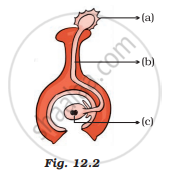Advertisements
Advertisements
Question
Length of pollen tube depends on the distance between
Options
pollen grain and upper surface of stigma
pollen grain on upper surface of stigma and ovule
pollen grain in anther and upper surface of stigma
upper surface of stigma and lower part of style
Solution
pollen grain on upper surface of stigma and ovule
Explanation -
Once a pollen grain reaches on the stigma of the pistil, it germinates to form a pollen tube which grows down the style to reach the ovule present inside the ovary. So, the length of the pollen tube depends on the distance between the pollen grain on the upper surface of the stigma and the ovule.
APPEARS IN
RELATED QUESTIONS
What happens when a Planaria gets cut into two pieces?
On cutting the body of an organism into many pieces it was observed that many of these pieces developed as new individuals. Name the process and list two organisms in which this process may be observed. Draw a schematic diagram to illustrate the changes that are likely to be observed during the development of new individuals in any one of the organisms named.
Can you think of reasons why more complex organisms cannot give rise to new individuals through regeneration?
Fill in the following blank with suitable word :
Rose plants and sugar cane crop are usually grown by the ........... method.
Describe the layering method for the artificial propagation of plants. Illustrate your answer with the help of a labelled diagram. Name any five plants which are propagated by the layering method.
How does an Amoeba reproduce? Describe the process of reproduction in Amoeba with the help of labelled diagrams of different stages in its reproduction process.
One of the following organisms does not reproduce by budding. This is :
(a) Sponge
(b) Yeast
(c) Hydra
(d) Planaria
An animal which reproduces by the process of budding is :
(a) Plasmodium
(b) yeast
(c) Hydra
(d) Planaria
Which of the following is not a type of asexual reproduction in multicellular organisms?
In the diagram given in Figure 12.2 label the parts marked (a), (b) and (c).

